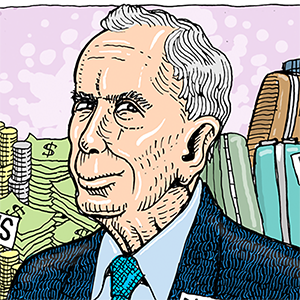What the Family and Medical Leave Act provides
Published in Health & Fitness
Since 1993, the Family and Medical Leave Act (FMLA) has protected employees who need to take time off from work to care for themselves or others. The federal law requires employers to provide workers up to 12 weeks off for medical leave, for the birth of a child or placement of a child for adoption or foster care, or to care for an immediate family member with a serious health condition. The law also covers a spouse, child or parent who takes leave to care for a military member with a serious injury or illness or to make certain arrangements (such as for child care) while a service member is deployed. Your employer isn’t required to pay you for the time off, but the law protects your job, and your employer must continue to provide your benefits, such as health insurance.
Michelle Paggi, a gerontologist and licensed psychologist in New York City, remembers how helpful the FMLA was for her mother when her grandmother was diagnosed with terminal lung cancer. Paggi’s mom, a health unit coordinator at a hospital, needed to take time off to care for Paggi’s grandmother and feared losing her job. “It was very aggressive cancer, and my grandmother had a lot of appointments. She needed my mom there as her primary caregiver,” says Paggi. “My mom was only in her 50s, so she needed the health insurance and was in no position to quit her job.”
Paggi’s mother found out about FMLA protections from a coworker, and she started accumulating overtime hours so she could continue to get paid when she took time off from work. “The FMLA gave her the flexibility to take care of my grandmother and still be able to hold on to her job,” Paggi says.
While many people know they can use the FMLA to take time off after having a baby, they don’t realize that it can also help when caring for a sick or aging relative. The law “recognizes the fact that there are over 53 million Americans providing on-going complex care for a loved one with a serious illness or disability or who is aging and requires care,” says Jason Resendez, president and CEO of the National Alliance for Caregiving. “According to our data, over 60% of family caregivers are working while providing care. Of those employed caregivers, over 50% are working full-time. There’s a balancing act between providing care and needing to put food on the table and stay in the workforce. FMLA provides a basic safety net for those caregivers.”
FMLA leave is not guaranteed to everyone. You’re eligible only if you work for a public agency of any size or a private company with 50 or more employees, you have worked there for at least 12 months, and you worked at least 1,250 hours during that year (about 24 hours per week). That covers about 56% of employees, says Molly Weston Williamson, senior fellow at the Center for American Progress.
People who care for extended family members are also excluded. For example, the law doesn’t cover time off to care for an aunt or grandparent, Resendez says. When Catherine Collinson, CEO and president of the Transamerica Center for Retirement Studies, was in her 40s, she asked her employer about using the FMLA to help care for her grandmother, who had suffered a stroke (her mother had passed away years earlier). That’s when she discovered that caring for a grandparent isn’t covered by the FMLA.
Fortunately, she was able to make a flexible work arrangement with her employer so she could keep her job while caring for her grandmother, and the company’s employee assistance program helped her find backup care. Her grandmother lived for five years after having the stroke.
If you aren’t eligible for FMLA protections, talk about your situation with your employer and find out whether it offers any benefits. “Learn what is available to you,” says Collinson.
State programs
Because of the FMLA’s limitations, many states have attempted to fill in some of the gaps. Some states have required smaller employers to offer the leave or expanded eligibility to workers who need to care for siblings, grandparents, in-laws and sometimes domestic partners, says Usha Ranji, associate director for women’s health policy for KFF, a nonprofit health-policy research, polling and news organization.
More significantly, a growing number of states have implemented paid-leave programs. Thirteen states and Washington, D.C., have passed laws that guarantee paid family and medical leave, which typically include the needs covered by the FMLA, Weston Williamson says. The programs in four of those states take effect in 2025 or 2026. (KFF provides a list of the states at https://tinyurl.com/y2twjss9.) The types of care that are covered can vary by state. Some states offer paid benefits only for medical leave, or for caregiving leave and/or parental leave, but not all three.
You typically apply for paid family leave through your state’s department of labor or paid family leave agency. Workers and employers usually pay into an insurance system, which covers the benefits when workers take leave, Weston Williamson says. You may get a percentage of your salary, up to certain limits — 60% to 80% is typical, says Ranji.
How to take family leave
Start by contacting your employer’s human resources department. Although in many cases the need comes up at the last minute, you generally must provide advance notice of 30 days for scheduled events, such as a new baby or planned surgery.
A health care provider typically must complete medical certification to support the need for leave, which can be for several weeks at a time or up to the equivalent of 12 weeks per year. The law allows employees to take intermittent blocks of time for a single reason, such as flare-ups of chronic conditions or recurring caregiving responsibilities, says Maria Medina, HR knowledge adviser for the Society for Human Resource Management. Examples of situations in which the FMLA can be used continuously include a serious medical condition that requires recovery time, pregnancy that entails bed rest, or inpatient treatment for mental health conditions. For more information, see the Department of Labor’s FMLA resources at www.dol.gov/agencies/whd/fmla.
More Help: Some states offer paid family caregiver programs
In response to the COVID-19 pandemic, the federal government allowed states to use Medicaid funds to pay family caregivers, says the National Alliance for Caregiving's Resendez. More than 40 states expanded their ability to provide direct compensation to family members, although some scaled back their programs after the COVID public health emergency ended.
The person receiving the care generally needs to be eligible for Medicaid, and the family member may need to register with a home health agency to get paid for providing the care, says Alice Burns, an associate director of the Program on Medicaid and the Uninsured for KFF, a nonprofit health-policy research organization.
Eligibility varies by state. Some states cover care only for family members with developmental disabilities, while other states limit the program to relatives age 65 and older or with physical disabilities.
For more information, go to www.kff.org/medicaid or contact your state Medicaid program. Burns also recommends contacting an Area Agency on Aging near you to find out about state programs for older relatives. You can search by your zip code or city and state at https://eldercare.acl.gov.
(Kimberly Lankford is a contributing editor for Kiplinger's Personal Finance.)
©2024 The Kiplinger Washington Editors, Inc. All rights reserved. Distributed by Tribune Content Agency, LLC.










Comments